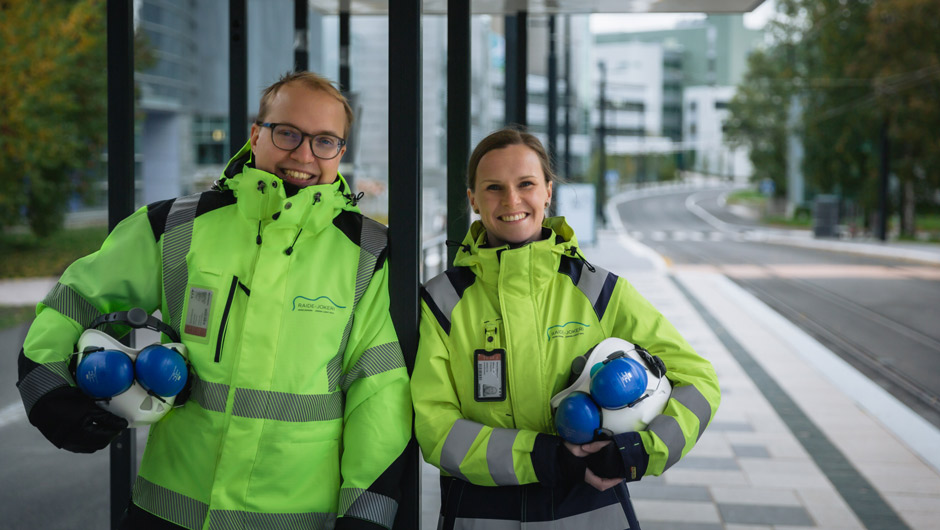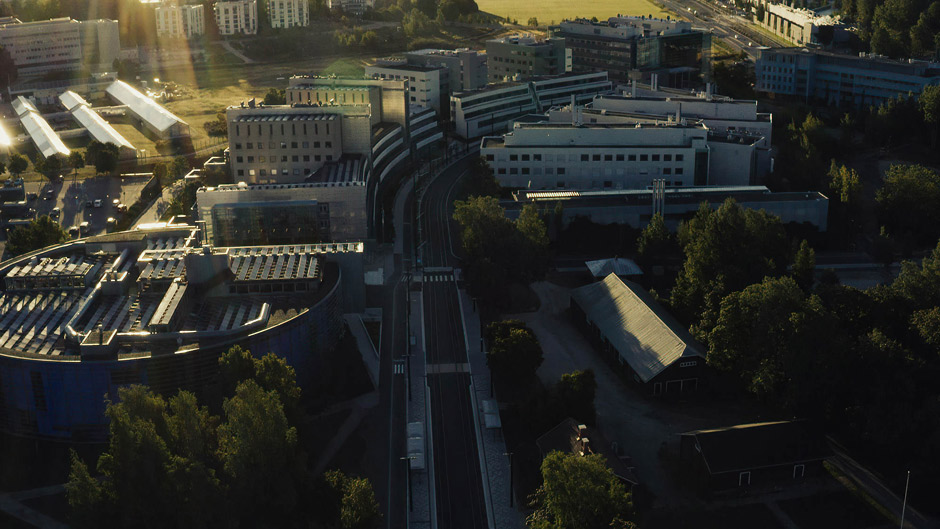- Projektitarina
- 11/9/2022
- 1963 views
In the Jokeri Light Rail project, environmental values are taken into account and you learn something new every day – "Basically, this is like 40 roadwork sites in a row"
A wide range of highly skilled construction professionals have been involved in the construction of Jokeri Light Rail, a tram line between Itäkeskus in Helsinki and Keilaniemi in Espoo. The project is in its final stages, with test runs on the line starting this month. We asked two YIT employees to share their experiences on the Jokeri Light Rail construction project.

A wide range of highly skilled construction professionals have been involved in the construction of Jokeri Light Rail, a tram line between Itäkeskus in Helsinki and Keilaniemi in Espoo. The project is in its final stages, with test runs on the line starting this month. We asked two YIT employees to share their experiences on the Jokeri Light Rail construction project.
Jokeri Light Rail will eventually run on about 25 kilometres of track, of which about 16 kilometres will be in Helsinki and the remaining nine kilometres in Espoo, replacing the trunk bus route 550. The Area Manager Teemu Manninen who have been working in Viikinkaari worksite in Helsinki and the Jokeri Light Rail’s environmental engineer Henna Malmipuro, are both happy to have had the opportunity to be involved with the Jokeri Light Rail project.
"We have had absolutely amazing colleagues on the Jokeri Light Rail project! That's why it's been so nice to come to work every morning. However, we are already beginning to feel a certain nostalgia as we are about to finish this magnificent project," Henna says.
Teemu adds that the Jokeri Light Rail project has been truly unique. For him, this was the first time he took part in an alliance project.
"What makes Viikinkaari a great project is that every half-kilometer stretch of the project has included most of the different types of infrastructure work. Basically, the Jokeri Light Rail is a bit like 40 roadwork sites in a row."
 The photo was not taken at the construction site, but at the finished stop.
The photo was not taken at the construction site, but at the finished stop.
Overcoming challenges
However, the project has not lacked challenges. Teemu and Henna say that Viikinkaari has involved a wide range of affected parties, including the university and other private entities. In their laboratories they use vibration-sensitive equipment, which had to be taken into account in the construction work.
"It was very important that they should be able to continue their activities with as little disruption as possible. The special requirements were taken into account in the scheduling. Among other things, pile-driving work was scheduled so as to minimise disruption time. Equipment was protected and moved to better locations within the properties," says Teemu.
Regular contact with the parties concerned has been maintained throughout the construction process. During the coronavirus pandemic, all contacts have been virtual.
"Given that this is a three-year project, they were a bit worried at first. Their worst fear was that they wouldn't be able to do any research or use their lab equipment. We were able to allay their fears relatively quickly. Research activities have continued, except for the occasional pile-driving day, for example," says Teemu.
Other challenges related to the Viikinkaari area include soil and groundwater conditions. It has been necessary to decrease the groundwater level in the area.
"Therefore, we had to pump the water out of the trenches and the pumped volumes were quite high. The soil is fine silt or sand, which was a bit of a problem for us. We had to think about solids separation, how to get all the sand out of the water before it is discharged from the site," says Henna.
Another challenge has been the site's location in the middle of the most densely populated part of Finland, which has meant that the site area has been rather cramped, with many properties nearby and heavy traffic around the site.
"But in the end we can be proud of ourselves for overcoming all the challenges," Henna says.
You learn something new every day
Teemu was originally trained as a horticulture specialist at the University of Applied Sciences. He feels that his different educational background has been useful in the construction industry, for example in terms of landscape visions. He has nearly completed his civil engineering studies. In contrast, Henna's path to the construction industry has been more traditional. She is an environmental engineer by training.
"I originally came to YIT and Jokeri Light Rail from the consulting world. An ex-colleague called to say that YIT was looking for an environmental engineer for the project. I decided to apply for the position. I was then hired."
Henna's main motivation to switch from consulting to the construction industry was that YIT offered good career development opportunities.
"I wanted to see things from a slightly different perspective and also to have a say in how ways of working could be developed and improved."
So what has been best about the Jokeri Light Rail project?
"Every day I have learned something new, which has been amazing. The project also involves a large number of experts and professionals from different fields."

Focus on nature and environmental values
Henna has been part of the Jokeri Light Rail environmental team and is proud of the project in many ways. A lot of work has been done for the environment.
"From the outset, it was decided that the construction of Jokeri Light Rail should be carried out with nature and environmental values in mind. As we build, we can take a lot of measures to preserve biodiversity; for example, we have restored streams to make them more suitable for trout."
"The project is located in the Helsinki metropolitan area, but is close to areas such as Natura sites, trout streams and other urban streams. There are also flying squirrel breeding and resting areas, as well as other natural habitats. Usually when we talk about construction, improving the state of nature and natural organisms is not the first thing that comes to mind, but in fact we can achieve a lot in that area as well," Teemu adds.
According to him, the project has been extremely successful in treating surface runoff at the construction site.
"We have also come up with good solutions to minimise disturbance to residents, for example through noise abatement. As a YIT employee, I am proud that we are able to influence the way in which working practices improve," he adds.
Overall, Teemu says the project has gone well.
"This is a joint effort involving several partners and subcontractors; it's not like we did this alone," Teemu concludes.
Increased understanding of construction
Teemu and Henna are pleased that the project has added the awareness of what construction really is. In the end, laying the rails is only a small part of the whole, with a lot of work being done under the rails.
"People often complain about why it takes so long to build. However, there is usually always a reason for the duration. There have been several different operators on this stretch, and there were separate contracts for district heating and gas pipeline installation, for example," Teemu says.
"We are building a light railway, and people may not realise how much we have to replace or renovate sewers, cables and everything that's under the ground or shift these things away from under the track. People may think that we just lay down the tracks, but in reality it's not that simple," Henna continues.
In Finland, we need to work more than many other countries with the foundations, because we have cold winters and soil frost.
"Many other parts of the world can cope with less work on the foundations, but in Finland you have to take all conditions into account. When the foundation is well-built, it ensures that the tram will run for the next hundred years as designed," explains Teemu.